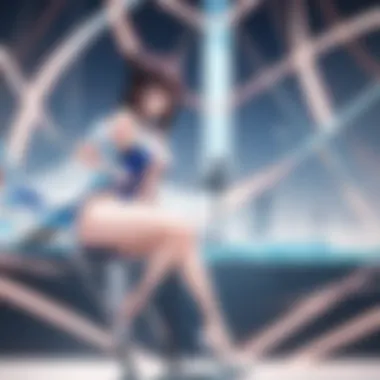In-Depth Look at Keijo Anime: Themes and Impact


Intro
Keijo, often surfacing as a controversial yet fascinating sub-genre of sports anime, is a curious blend of athletic competition and quirky humor. Despite its seemingly frivolous premise, there lies an intricate web of narrative and character development that invites anime enthusiasts to look beyond the surface. This comprehensive analysis seeks to peel back the layers of Keijo, revealing not only its unique storyline but also the broader cultural implications tied to its themes.
At first glance, it may appear as if Keijo is merely an over-the-top spectacle. Teeming with a multitude of characters competing in outrageous matches using only their bodies, this genre thrives on the absurd. However, what sets it apart from typical sports anime is the underlying sense of camaraderie, ambition, and the relentless pursuit of dreams. This article aims to delve into the very essence of Keijo, exploring its narrative intricacies, character dynamics, and the wider discourse it generates within contemporary anime culture.
Let’s embark on this journey through the world of Keijo anime, dissecting its layers and uncovering what truly makes it a distinctive presence in the realm of anime.
Prolusion to Keijo Anime
In the vast landscape of anime, Keijo serves as a unique genre that intertwines sports, humor, and social commentary. Its growing popularity can’t be overlooked. This introduction aims to lay the groundwork for discussing Keijo by delving into its essential qualities, the societal implications of its storylines, and its overall contribution to the anime culture.
Defining Keijo
Keijo goes beyond mere athletic pursuits; it combines an imaginative take on sports with striking visuals and an often ridiculous sense of humor. Originally coming to prominence through series like Keijo!!!!!!!!, it features female competitors engaging in an unconventional form of sports that involves using only their bodies to push opponents out of a designated area on water-filled platforms. Despite the eclectic premise, the genre touches on strong themes of competition, camaraderie, and empowerment, often lending itself to deeper reflections on gender and societal norms.
The term ‘Keijo’ itself encapsulates this vibrant energy, where athletes are not only battling for victory but also showcasing their resilience against societal stereotypes. Players develop unique skills and strategies that often play against expected norms, making it a rich topic for exploration.
The Appeal of Sports Themes in Anime
Sports-themed anime have long held a cherished place in the hearts of fans. This appeal lies not only in the thrilling athletic competition but also in the personal growth depicted throughout the characters’ journeys. Often, these narratives mirror real-life challenges, making them relatable and inspiring. In Keijo, this becomes especially poignant as we see characters overcoming physical and emotional barriers, fighting for their dreams.
Furthermore, Keijo draws humor from its exaggerated depictions of athletic prowess coupled with somewhat risqué situations. This mix creates a charming contrast that keeps viewers engaged. Additionally, the community aspect of sports, where friendships are forged through competition, resonates well with many fans.
- Relatable Growth: Characters often face struggles that viewers can relate to, making their victories all the more gratifying.
- Humor and Escapism: The absurdity of the sport allows for moments of levity, providing a break from more serious topics.
- Empowerment Themes: The portrayal of strong female characters striving for success informs and empowers the audience, challenging traditional gender roles.
The multidimensional nature of anime like Keijo illustrates various important aspects of competition while simultaneously entertaining audiences through its unique concept.
In summary, by merging fantastical sports mechanics with poignant themes of empowerment, Keijo stands as a remarkable conversation starter in the broader anime narrative. As we delve deeper into this analysis, we will examine these facets more closely and uncover the layers that contribute to its cultural significance.
Historical Context
Understanding the historical context of Keijo anime is essential for grasping its evolution and significance within the broader landscape of anime and manga culture. This genre did not emerge from a vacuum; instead, it was shaped by various shifts in societal trends, consumer interests, and the ongoing dialogue around gender representation in media. The roots of Keijo can be observed in the evolution of sports anime in general, as well as the specific antics of ecchi and shonen genres.
Emergence of Keijo as a Genre
Keijo, as a specific genre of anime, made its entry into the spotlight primarily during the mid-2010s, stemming from a manga series created by Daichi Shiratori. The concept is simple yet provocative: female competitors engage in a unique sport where the objective is to knock opponents off a floating platform using only their breasts and buttocks. This sheer absurdity appealed to a niche audience and became a vehicle for both comedic and serious themes.
Due to the fantastic nature of its premise, Keijo quickly carved its niche. The sport, blending athleticism with overt sexual suggestiveness, allows for a rich exploration of character motivations and societal norms. Unlike traditional sports anime that often focused on hard training and competition, Keijo brought a whimsical yet earnest take on the sports genre, as players navigated both physical trials and social challenges.
In addition, the series gained traction by showcasing vibrant animation styles, colorful characters, and high-energy matches, ultimately signifying a new chapter in how sports narratives could be told within anime. The characters represented a blend of archetypes familiar to fans, yet each brought their unique flair to the roster, creating a tapestry of relationships that resonated with viewers.
Influence of Shonen and Ecchi Genres
To comprehend the rise of Keijo, one must consider the influences of both the shonen and ecchi genres that have long thrived in anime. The shonen genre, aimed primarily at a young male audience, traditionally romanticizes themes of camaraderie, competition, and the struggle for self-improvement. These elements are evident in Keijo's structure, where character growth is tied intricately to their performance in matches, not unlike battle-hardened heroes in classic shonen narratives.
On the other hand, the ecchi genre has paved the way for more suggestive content that plays with sexuality while often retaining comedic or light-hearted tones. Emphasizing fan service, ecchi allows for the inclusion of exaggerated attributes and scenarios that appeal to viewers seeking a blend of entertainment and titillation. Keijo dances this tightrope quite adeptly, intertwining sports action with playful imagery and innuendo, making it both a spectacle and a talking point for discussions around gender.
As fans dig deeper into Keijo, it becomes apparent how the blend of these two genres shapes its narrative and appeal. The empowering arcs for many female characters serve to challenge traditional views of femininity while also paying homage to the crass humor found in ecchi series. Thus, Keijo is not merely a diversion; it is an exploration of cultural norms through a lens that combines competition with gender identity, athleticism with suggestion. The overwhelming success of this genre highlights the audience's craving for something fresh, yet steeped in familiar tropes.
"Keijo is a compelling mirror reflecting societal trends and attitudes toward gender and competition while spark igniting discussions on empowerment and objectification."


In essence, the historical context of Keijo anime lays the groundwork for understanding its subsequent developments in character arcs and thematic explorations. By examining the influences that shaped it, we can appreciate the multi-layered complexities that make this genre unique, paving the way for deeper analysis in the subsequent sections.
Key Elements of Keijo
In any genre, certain elements forge the identity and distinctive characteristics that capture the audience's imagination. In the context of Keijo anime, these key elements play a crucial role in shaping the narrative, enhancing viewer engagement, and driving the thematic exploration of the series. By investigating these components, we can gain insights into why Keijo has solidified its place in the vast universe of anime.
Character Types and Archetypes
Keijo thrives on a diverse cast that brings to life a variety of character types and archetypes. The protagonists often embody traditional sports hero traits—tenacity, righteous spirit, and a thirst for victory. Take the lead character, Nozomi, for instance; she is not only driven by her competitive spirit but also showcases a deep sense of camaraderie with her peers, reflecting the bonds formed around shared goals and struggles.
On the flip side, antagonists are crafted to embody contrasting philosophies. They might represent the darker side of ambition, showcasing a willingness to exploit weaknesses and bend rules in pursuit of victory. Such dualities create a rich tapestry of motivation that engages viewers on multiple levels, as they root for the underdog while simultaneously questioning the integrity of their opponents.
Examples of Key Archetypes
- The Underdog: Often facing overwhelming odds, this character type resonates with viewers. Their journey often encapsulates the struggle to rise against adversity.
- The Mentor: Typically older or more experienced, these characters guide the protagonists with wisdom and tactical knowledge, adding depth to character interactions.
- The Rival: Serving as the protagonist's counterpart, they elevate the stakes and challenge the hero to evolve.
This assortment of archetypes not only helps in storytelling but also mirrors the complexities of real-life competition and camaraderie, making it easier for viewers to relate to the characters and their journeys.
Unique Sports Mechanics
Keijo sets itself apart through its unique take on sports mechanics. At first glance, the sport may appear frivolous; participants compete through unexpected means such as battling via their bodies, using strategic tackles and acrobatics to knock opponents off platforms over water. This unconventional approach encourages not just physical prowess but also the tactical application of skills.
Every match serves as a microcosm showcasing different strategies and techniques. Viewers might witness a character performing a high-risk maneuver, putting everything on the line. Episodes dedicated to specific techniques delve into the physics of movement and the mental aspects of sports strategy, meticulously choreographed to create tension and excitement.
This blend of athleticism coupled with entertainment can draw viewers in, compelling them to explore the layered strategies behind each encounter. Thus, the mechanics are integral, allowing fans to appreciate the artistic choreography involved which extends beyond simple team sports.
Visual and Aesthetic Language
The visual presentation in Keijo is another significant element that enhances its allure. The animation style is vibrant, mirroring the energy of the sport itself. Typically characterized by fluid motion and exaggerated expressions, the artwork creates an engaging atmosphere that complements the high-stakes nature of the sport.
Key Aspects of Visual Language:
- Color Palette: Bright, bold colors are used to evoke emotions and underline moments of triumph or defeat.
- Character Design: Unique hairstyles, outfits, and body types not only set characters apart but also define their personalities.
- Animation Techniques: Fluid animation enhances the physicality of the sport, making every movement crucial and impactful.
The aesthetics serve an important narrative function; they push the limits of traditional sports anime while ensuring that every scene is visually stimulating. Moreover, attention to detail in facial expressions can convey emotions, thus pulling the viewer further into the emotional landscape of the characters.
"Keijo offers not just a sport; it crafts a vibrant world where each character’s journey is as compelling as the matches they partake in."
These elements, when woven together, create not just a show to watch, but an experience that resonates with anime fans and sports enthusiasts alike. In essence, the key elements of Keijo cumulatively reflect its unique contributions to the anime landscape, carving out its niche in a genre that constantly evolves.
Narrative Structure and Themes
In exploring Keijo, examining its narrative structure and themes helps illuminate the deeper layers within the genre. On the surface, one might label it as simply a sports anime featuring women competing in a rather outlandish sport, but a closer inspection reveals many compelling elements at play. The interplay of sportsmanship, character growth, and social commentary takes shape through various storytelling techniques, enriching the viewer's experience.
The Hero’s Journey in Keijo
Central to many anime narratives, the Hero's Journey provides a familiar framework that resonates with audiences. Keijo's protagonists—often ambitious and relatable—embark on a quest for personal growth and achievement. Take Nozomi Kaminashi, for instance. Initially, she starts off with raw talent and determination, but throughout the episodes, faces numerous obstacles. Each challenge brings her closer to her ultimate goal, not just in terms of winning competitions, but in understanding her own strengths and weaknesses.
- Call to Adventure: Nozomi's entry into the Keijo arena introduces the exhilarating and competitive world, sparking her journey.
- Trials and Allies: As she trains and competes, she encounters various rivals and allies, helping her to evolve and adapt.
- Growth and Transformation: The layers of character development become prominent during her high-stakes matches, where skill, strategy, and resolve intermingle.
This structure not only reflects individual character arcs but also engages viewers emotionally, allowing them to cheer on their favorite characters.


Exploration of Gender and Empowerment
The themes of gender and empowerment are intricately woven into the fabric of Keijo. While the anime's premise may raise eyebrows and critique, it also shines a light on female strength and agency. Characters like Rinrin Manaka defy traditional roles, asserting their skills and autonomy in a genre dominated by male characters. Their victories showcase empowerment, both within the narrative and as a broader social statement.
"Keijo presents female characters that are not just sidelined but are active participants, striving to prove their worth in a competitive arena."
The sport serves as a metaphor for breaking stereotypes. Women are often pigeonholed into specific societal roles, yet Keijo's female athletes challenge these norms, pushing boundaries in ways that are refreshing and thought-provoking.
Humor and Seriousness
Keijo expertly balances humor with serious undertones, creating a dynamic viewing experience. This blend of comedic moments, often stemming from absurd characters or exaggerated situations, provides levity amidst the competitive context. For example, scenes featuring outlandish training methods or rivalry antics showcase a humorous take on the often serious nature of sports.
However, the humor does not detract from the narrative’s significance. Instead, it enhances character relationships and emphasizes their struggles and victories. The seriousness of themes such as overcoming adversity and embracing identity coexist beautifully with moments of levity, facilitating a deeper emotional connection.
In summary, the narrative structure and themes, from the Hero's Journey to the exploration of empowerment and the balance of humor and seriousness, reveal that Keijo is more than a peculiar sports anime. It’s a narrative that invites both laughter and reflection, urging viewers to look beyond the surface and engage with the intricate world of its characters.
Character Analysis
Understanding character dynamics in Keijo is pivotal to unlocking the intricate layers of its narrative. These characters aren't mere vessels for sport or comedy; they serve as lenses through which the audience can explore themes such as competition, camaraderie, and personal growth. Each character, from the lead protagonists to the nuanced supporting roles, is designed to reflect deep-rooted beliefs and aspirations, revealing how individuals navigate their ambitions within a competitive arena. Moreover, character analysis provides insight into how Keijo manages to blend serious undertones with lighthearted moments, making the series appealing across a wide spectrum of viewers.
Protagonists and Antagonists
In the world of Keijo, protagonists are often portrayed as tenacious underdogs battling against obstacles both on and off the field. Characters like Nozomi Kaminashi epitomize the relatable journey of overcoming adversity with unwavering determination. Her backstory, filled with the struggle to adapt and excel in a male-dominated sport, offers a glimpse into the pressures and joys faced by female athletes. On the flip side, the antagonists often embody the traditional traits of formidable rivals, pushing the protagonists to their limits. For instance, characters like Sayaka Miyata display not merely strength but an intricate blend of ambition and personality that adds depth to their rivalry. This duality enhances the storytelling, as viewers are engaged not only with the competition but also with the emotional stakes behind it.
Supporting Roles and Their Importance
The supporting characters in Keijo play essential roles in enriching the main narrative. They often serve as catalysts for the protagonists' development, providing much-needed guidance, comic relief, or even motivational barriers to hurdle over. Characters such as the cheerful and optimistic friends often emphasize the importance of teamwork and friendship, showcasing how relational dynamics can influence personal achievements. Their diverse personalities bring texture to the competitive environment, reminding audiences that the journey in sports is rarely a solitary one. The inclusion of varied backgrounds and perspectives among supporting characters enriches the series, making it relatable to a broader audience.
Character Development Over Time
Character development in Keijo reflects a dynamic evolution influenced by both personal and external challenges. Over the course of the series, characters confront their fears, question their motivations, and ultimately grow into more complex individuals. For instance, Nozomi's victories and setbacks contribute not just to her skills but also to her emotional maturity. This gradual development illustrates a key aspect of sports - the journey of self-discovery through competition.
In addition, the characters' arcs often intersect, creating opportunities for alliances and rivalries to evolve. This interconnectedness amplifies the overall tension and excitement within the narrative. Fans become invested not just in individual victories but also in the growth of relationships, emotional resilience, and the pursuit of personal dreams. The way characters adapt to challenges and learn from each other offers profound lessons that resonate beyond the fictional world of Keijo, highlighting that growth often comes hand in hand with hardship.
"The richness of character in Keijo serves a greater purpose than mere entertainment; it is a reflection of the challenges faced in our own lives, making even the most fantastical elements relatable."
Through these complex character explorations, Keijo succeeds in crafting a compelling narrative that keeps audiences engaged while also facilitating deeper conversations around the essence of competition, identity, and empowerment in a society that often pressures individuals to conform.
Cultural Impact and Reception
The cultural impact of Keijo anime is profound, reaching beyond its primary audience and stirring conversations in various spheres, including social media and fan communities. This anime genre has managed to craft a distinct niche that combines the thrill of sports with humor and visual appeal. It provides viewers with not just entertainment but a canvas to explore deeper themes surrounding empowerment, gender dynamics, and the nature of competition.
Fan Communities and Engagement
In the landscape of anime, fan communities surrounding Keijo have flourished, providing a space for discussions, art, and theory crafting. These communities thrive on platforms like Reddit, where users eagerly exchange perspectives, share fan art, and analyze character arcs.
By bonding over shared enthusiasm, fans create an ecosystem that enriches their experience of the anime. Fan art, cosplay, and even fanfiction are common ways that enthusiasts express their love for the series. Moreover, conventions often see a surge of Keijo-inspired costumes, demonstrating the show's lasting influence and popularity among its followers.
"Keijo isn't just a show; it's a lifestyle for many of its fans. They breathe life into those characters every chance they get."
Criticism and Controversy


Despite its fanfare, Keijo has not been without its share of criticisms and controversy. Some viewers have expressed discomfort with the overtly ecchi elements, which combine sexual innuendo with athletic competition. This portrayal raises questions about the objectification of female characters in sports settings. Critics argue that while the series can be seen as empowering, it also risks reinforcing harmful stereotypes. The discourse surrounding these themes often leads to heated debates, which only further entrench Keijo's place in anime culture.
This duality of appeal and criticism continues to shape how Keijo is perceived, leading to a nuanced discussion among audiences about representation in anime and what that entails for different demographics.
Legacy of Keijo in Modern Anime
The legacy of Keijo in the anime world is significant, marking a clear thesis on how niche genres can find their way into broader popular culture. The show has prompted discussions about the portrayal of sports and gender, influencing subsequent works that draw on similar themes.
Various new anime series have incorporated aspects of Keijo's unique blend of humor and sports. Instances can be seen in other sports-focused anime that take cues from its playful attitude, creating a ripple effect that can alter viewer expectations.
As we consider the ongoing evolution of anime, Keijo serves as a reminder that even the most unconventional themes can resonate with audiences. This legacy suggests that as anime continues to diversify, so too will the themes and narratives that captivate both new and veteran viewers alike.
By examining the cultural impact and reception of Keijo, we gain insight into how niche anime can reflect and even shape societal conversations.
Comparative Analysis
When discussing Keijo, it’s essential to place it in the wider context of anime genres. Comparative analysis not only reveals the unique elements that constitute Keijo but also illustrates its standing compared to its contemporaries. By examining Keijo alongside other sports anime and martial arts series, we can uncover the specific characteristics that set it apart, while also recognizing common threads that run through these genres.
Through this lens, the discussion gains depth, as we consider the artistic decisions, thematic concerns, and audience engagement strategies that differentiate Keijo within the slim landscape of sports-centered anime. Moreover, this analytical approach sheds light on why Keijo resonates with its audience in ways that may differ from other shows. For viewers and critics alike, understanding these parallels and divergences provides a clearer appreciation for the artistry and efficacy behind the series.
Keijo vs. Other Sports Anime
Keijo embodies a distinctive facet of the sports anime genre. While traditional sports anime like Haikyuu!! or Kuroko no Basket focus primarily on established sports such as volleyball or basketball, Keijo carves its niche by centering around its unique game that involves physicality and strategy in a distinctly exaggerated manner. Here are several key distinctions and contrasts:
- Game Mechanics: Keijo introduces a game focused on using only the buttocks and breasts to knock opponents off a floating platform. In comparison, sports anime generally focus on conventional rules and established gameplay. The novelty of Keijo’s gameplay piques curiosity and sets it apart instantly.
- Character Motivation: Often, protagonists in other sports anime strive for glory or personal achievements through teamwork and sportsmanship. In Keijo, the motivations tend to veer towards survival in a competitive, sometimes ruthless arena that prioritizes entertainment and spectacle as much as athletic skill.
- Audience Expectation: Fans of shows like Yuri on Ice or Free! may come expecting a narrative that sensitively explores character arcs intertwined with their sports journey. In contrast, the audience of Keijo often anticipates a wild blend of comedy, fan service, and over-the-top action, all made digestible through its absurd premise.
The divergence in approach allows Keijo to occupy a surreal, entertaining corner of the anime spectrum, drawing diverse audience segments who may not be interested in traditional sports narratives.
Similarities with Martial Arts-Based Series
While Keijo may center on an unconventional sport, its roots in martial arts folklore cannot be overlooked. Both genres prioritize physical prowess, strategy, and character development but do so through distinct lenses. Here are some notable similarities:
- Skills and Techniques: Just like martial arts series such as Baki the Grappler or Hajime no Ippo, Keijo emphasizes mastering techniques. Characters often undergo rigorous training and develop unique styles rooted in their primal game mechanics.
- Individual and Team Rivalry: Similar to how martial arts often showcase one-on-one duels or tournaments, Keijo instills a sense of rivalries among characters, fostering an environment where personal skills and tactics come to the forefront. The interplay of competition mirrors the martial spirit sparked in a dojo.
- Character Journeys: Both genres present characters undergoing transformative journeys. In martial arts, growth often arises through discipline and overcoming obstacles. In Keijo, characters evolve by honing their skills and facing unique challenges, albeit within a more whimsical setting.
This comparative backdrop reveals how Keijo, while a genre on its own, shares a dynamic interplay with both sports and martial arts anime, emphasizing the creative versatility of anime at large.
"Understanding the differences and similarities between Keijo and other genres enriches the viewer's experience and appreciation for the expansive anime landscape."
In essence, the comparative analysis offers invaluable insights into Keijo, showcasing its multifaceted existence within the broader anime context.
Culmination
In the exploration of Keijo, it's crucial to understand the distinct dynamics that define its essence as a genre. From its roots in sports to the layers of gender commentary, Keijo presents a unique blend of themes that warrant attention. This article unpacks these themes effectively, taking a closer look at how the series appeals not just to sports fans, but also to those interested in deeper narratives about empowerment and society.
The journey through this multifaceted anime reveals various significant elements, particularly its ability to connect with viewers through character development, community engagement, and its humorous yet serious stance on sports and competition. The portrayal of physicality, along with the quick wit of its dialogue, creates a captivating viewing experience.
Summary of Findings
In summation, several key findings emerge from our analysis of Keijo:
- Cultural Resonance: Keijo taps into a unique cultural moment. Its themes resonate on several levels, encouraging discussions about women's empowerment within sports, all while infusing humor and light-heartedness.
- Character Dynamics: The character tropes, from the fierce protagonist to the antagonistic forces, reflect typical sports narratives, yet are enhanced by their playful eccentricities and relationships.
- Sociological Implications: The genre acknowledges and critiques the expectations of femininity in sports, thereby paving the way for a broader discourse around gender roles in society.
"Keijo is not just about the sport; it’s a narrative that dares to challenge stereotypes, enticing a conversation far beyond anime.”
Future Prospects for Keijo and Anime as a Whole
Looking ahead, the prospects for Keijo—while somewhat niche—are shining bright. As the anime industry keeps evolving, genres that were once dismissed as silly are gaining recognition for their rich storytelling and characterization. Given this context, Keijo has the potential to grow even more in popularity among varied audiences.
- Innovative Storytelling: Future installments or spin-offs could further explore the delicate balance between humor and seriousness, giving rise to richer narratives.
- Increased Diversity: As more viewers demand representation and complexity in their viewing choices, Keijo could pivot to encapsulate broader identities and experiences in future adaptations.
- Global Reach: With the rise of streaming platforms, international audiences might develop interest, pushing Keijo into mainstream consciousness, potentially leading to collaborations or cross-genre productions.







